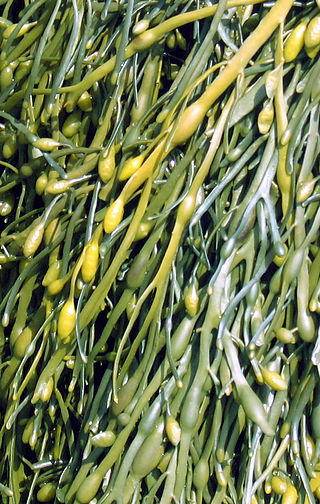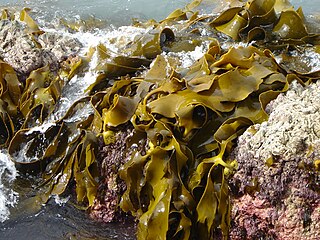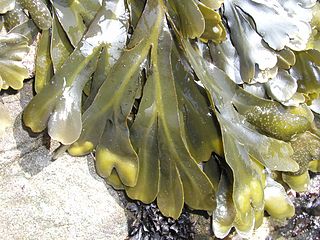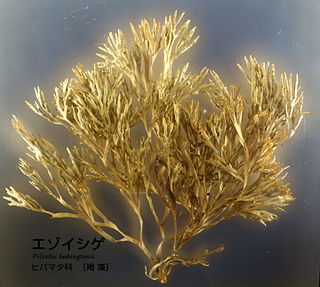
Fucus vesiculosus, known by the common names bladderwrack, black tang, rockweed, sea grapes, bladder fucus, sea oak, cut weed, dyers fucus, red fucus and rock wrack, is a seaweed found on the coasts of the North Sea, the western Baltic Sea and the Atlantic and Pacific Oceans. It was the original source of iodine, discovered in 1811, and was used extensively to treat goitre, a swelling of the thyroid gland related to iodine deficiency.

Brown algae are a large group of multicellular algae comprising the class Phaeophyceae. They include many seaweeds located in colder waters of the Northern Hemisphere. Brown algae are the major seaweeds of the temperate and polar regions. Many brown algae, such as members of the order Fucales, commonly grow along rocky seashores. Most brown algae live in marine environments, where they play an important role both as food and as a potential habitat. For instance, Macrocystis, a kelp of the order Laminariales, may reach 60 m (200 ft) in length and forms prominent underwater kelp forests that contain a high level of biodiversity. Another example is Sargassum, which creates unique floating mats of seaweed in the tropical waters of the Sargasso Sea that serve as the habitats for many species. Some members of the class, such as kelps, are used by humans as food.
Pseudoalteromonas is a genus of marine bacteria. In 1995, Gauthier et al proposed Pseudoalteromonas as a new genus to be split from Alteromonas. The Pseudoalteromonas species that were described before 1995 were originally part of the genus Alteromonas, and were reassigned to Pseudoalteromonas based on their rRNA-DNA analysis.

Fucus is a genus of brown algae found in the intertidal zones of rocky seashores almost throughout the world.

Ascophyllum nodosum is a large, common cold water seaweed or brown alga (Phaeophyceae) in the family Fucaceae. Its common names include knotted wrack, egg wrack, feamainn bhuí, rockweed, knotted kelp and Norwegian kelp. It grows only in the northern Atlantic Ocean, along the north-western coast of Europe including east Greenland and the north-eastern coast of North America. Its range further south of these latitudes is limited by warmer ocean waters. It dominates the intertidal zone. Ascophyllum nodosum has been used numerous times in scientific research and has even been found to benefit humans through consumption.

Phlorotannins are a type of tannins found in brown algae such as kelps and rockweeds or sargassacean species, and in a lower amount also in some red algae. Contrary to hydrolysable or condensed tannins, these compounds are oligomers of phloroglucinol (polyphloroglucinols). As they are called tannins, they have the ability to precipitate proteins. It has been noticed that some phlorotannins have the ability to oxidize and form covalent bonds with some proteins. In contrast, under similar experimental conditions three types of terrestrial tannins apparently did not form covalent complexes with proteins.

Fucus distichus or rockweed is a species of brown alga in the family Fucaceae to be found in the intertidal zones of rocky seashores in the Northern Hemisphere, mostly in rock pools.

Fucus gardneri is a species of seaweed, a brown alga living on the littoral shore of the Pacific coasts of North America. It has the common names of rockweed and bladderwrack.
Pseudoalteromonas elyakovii is a marine bacterium.
Pseudoalteromonas flavipulchra is a rod-shaped gram-negative marine bacterium.
Pseudoalteromonas maricaloris is a marine bacterium which was isolated from the sponge Fascaplysinopsis reticulata in the Coral Sea.
Pseudoalteromonas paragorgicola is a marine bacterium isolated from a sponge in the Pacific Ocean.
Pseudoalteromonas ruthenica is a marine bacterium isolated from the mussel Crenomytilus grayanus and the scallop Patinopecten yessoensis in the Gulf of Peter the Great, Sea of Japan.
Pseudoalteromonas tetraodonis is a marine bacterium isolated from the surface slime of the puffer fish. It secretes the neurotoxin, tetrodotoxin. It was originally described in 1990 as Alteromonas tetraodonis but was reclassified in 2001 to the genus Pseudoalteromonas.
Pseudoalteromonas translucida is a marine bacterium isolated from the Gulf of Peter the Great in the Sea of Japan.
Pseudoalteromonas ulvae is a marine bacterium isolated from the alga Ulva lactuca at the intertidal zone near Sydney.
Fucus virsoides is a species of brown alga endemic to the Adriatic Sea. The Bay of Kotor was defined as one of the southernmost limits of Fucus virsoides.

Fucophlorethol A is a phlorotannin found in the brown alga Fucus vesiculosus.

Silvetia is a genus of brown algae, commonly known as rockweed, found in the intertidal zone of rocky seashores of the Pacific Ocean. These were originally classified as members of the genus Pelvetia. In 1999, Silvetia sp. was created as a separate species from Pelvetia canaliculata due to differences of oogonium structure and of nucleic acid sequences of the rDNA. It was renamed in honor of Paul Silva, Curator of Algae at the Herbarium of the University of California, Berkeley. There are three species and one subspecies.
Alkalihalobacillus algicola is a Gram-positive, spore-forming, aerobic and motile bacterium from the genus of Alkalihalobacillus which has been isolated from the alga Fucus evanescens.








